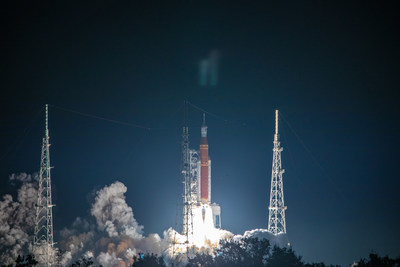Boeing-Built Space Launch System Core Stage Powers First NASA Artemis Mission to Moon
Rhea-AI Summary
NASA's Space Launch System rocket, featuring a core stage built by Boeing, successfully launched at 1:47 a.m. ET from Kennedy Space Center on November 16, 2022. This marks the first super-heavy lift launch capability in 50 years. The core stage executed critical functions, including fueling and engine ignition, and separated successfully from the upper stage, sending the Orion spacecraft on its maiden lunar journey. Boeing is preparing for future Artemis missions, with Core Stage-2 and 3 already in assembly.
Positive
- Successful launch of NASA's Space Launch System, marking a significant milestone for Boeing.
- Demonstration of critical engineering functions indicates readiness for future missions.
- Ongoing preparations for upcoming Artemis flights showcase Boeing's commitment to space exploration.
Negative
- None.
News Market Reaction 1 Alert
On the day this news was published, BA declined 1.52%, reflecting a mild negative market reaction.
Data tracked by StockTitan Argus on the day of publication.
KENNEDY SPACE CENTER, Fla., Nov. 16, 2022 /PRNewswire/ -- NASA's Space Launch System rocket, powered by the Boeing [NYSE: BA] -built core stage, lifted off at 1:47 a.m. ET from the Kennedy Space Center. Eight and a half minutes into flight, the core stage completed its mission and separated from the upper stage of the rocket, sending NASA's Orion spacecraft on its first journey around the Moon.
"Today, this country now has a super-heavy lift launch capability for the first time in 50 years," said Jim Chilton, senior vice president of Boeing's Space and Launch division. "This test flight was a demonstration of engineering innovation, and we are ready to support NASA and their international partners in returning humans to deep space exploration."
During the mission, the core stage demonstrated several important functions, including fueling both tanks, actuating the hydraulic system, igniting the engines, running thrust vector control programs in flight, depleting the fuel tanks, shutting down the engines, and conducting successful separation and disposal maneuvers.
"It was an absolutely beautiful launch – visually and technically," said John Shannon, vice president and program manager of Boeing's SLS program. "This rocket controls incredible forces while speeding through the atmosphere. It performed the mission as we designed it to do, and we thank our team and partners for all their hard work in making this first launch a success."
The core stage of the rocket stands at 212 feet (almost 65 meters), and is comprised of a 196,000-gallon liquid oxygen, a 537,000-gallon liquid hydrogen tank, along with an intertank section joining the two fuel reservoirs, a forward skirt on top that connects to the upper stage, and an engine section with four RS-25 engines combining for 2.2 million pounds of thrust. A Boeing team manufactures the core stage at NASA's Michoud Assembly Facility in New Orleans, Louisiana, and uses components made by more than 430 suppliers across the United States.
The Boeing team is preparing the next stages for their respective flights. Core Stage-2, or CS-2, will launch the first crew of the Artemis program and is in the final assembly area at Michoud. CS-3 is manifested to launch the first crewed lunar landing since Apollo, which will include the first woman and first person of color. That stage, as well as CS-4, are already in work at Michoud. Additionally, the structural test article of a newer, more powerful upper stage known as the Exploration Upper Stage is in fabrication.
As a leading global aerospace company, Boeing develops, manufactures and services commercial airplanes, defense products and space systems for customers in more than 150 countries. As a top U.S. exporter, the company leverages the talents of a global supplier base to advance economic opportunity, sustainability and community impact. Boeing's diverse team is committed to innovating for the future, leading with sustainability, and cultivating a culture based on the company's core values of safety, quality and integrity. Join our team and find your purpose at boeing.com/careers.
Contact
Media@boeing.com
![]() View original content to download multimedia:https://www.prnewswire.com/news-releases/boeing-built-space-launch-system-core-stage-powers-first-nasa-artemis-mission-to-moon-301679769.html
View original content to download multimedia:https://www.prnewswire.com/news-releases/boeing-built-space-launch-system-core-stage-powers-first-nasa-artemis-mission-to-moon-301679769.html
SOURCE Boeing








